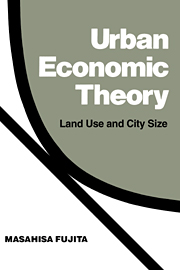Book contents
- Frontmatter
- Contents
- Preface
- 1 Introduction
- Part I Basic theory
- 2 Locational choice of the household
- 3 Equilibrium land use and optimal land use: single household type
- 4 Equilibrium land use and optimal land use: multiple household types
- 5 Urban aggregates and city sizes
- Part II Extensions with externalities
- Appendixes
- References
- Author index
- Subject index
2 - Locational choice of the household
Published online by Cambridge University Press: 23 December 2009
- Frontmatter
- Contents
- Preface
- 1 Introduction
- Part I Basic theory
- 2 Locational choice of the household
- 3 Equilibrium land use and optimal land use: single household type
- 4 Equilibrium land use and optimal land use: multiple household types
- 5 Urban aggregates and city sizes
- Part II Extensions with externalities
- Appendixes
- References
- Author index
- Subject index
Summary
Introduction
Any household that moves to a city and has to choose a residence is faced with a complex set of decisions. We can view this situation as a trade-off problem, in which there are three basic factors: accessibility, space, and environmental amenities.
Accessibility includes both pecuniary and time costs associated with getting to and from work, visiting relatives and friends, shopping, and other such activities. The space factor consists of the need for some land as well as the size and quality of the house itself. Finally, environmental amenities include natural features such as hills and scenic views as well as neighborhood characteristics ranging from quality of schools and safety to racial composition.
In making a residential choice a household must weigh all three factors appropriately, yet also meet budget and time constraints. For example, a location with good accessibility usually commands a high price for space. So the household may have to sacrifice space for accessibility. Accessible locations, however, are typically lacking in environmental quality. Thus, the household also confronts a choice between accessibility and environment.
Even though in actual practice all three factors are important for making a residential choice, when constructing theory it is difficult to treat all factors at once. Following the time-honored wisdom of theory building, we shall begin by studying a pure case and expand the framework later on. Part I examines the trade-off between accessibility and space in residential choice. Part II introduces environmental factors.
- Type
- Chapter
- Information
- Urban Economic TheoryLand Use and City Size, pp. 11 - 49Publisher: Cambridge University PressPrint publication year: 1989



